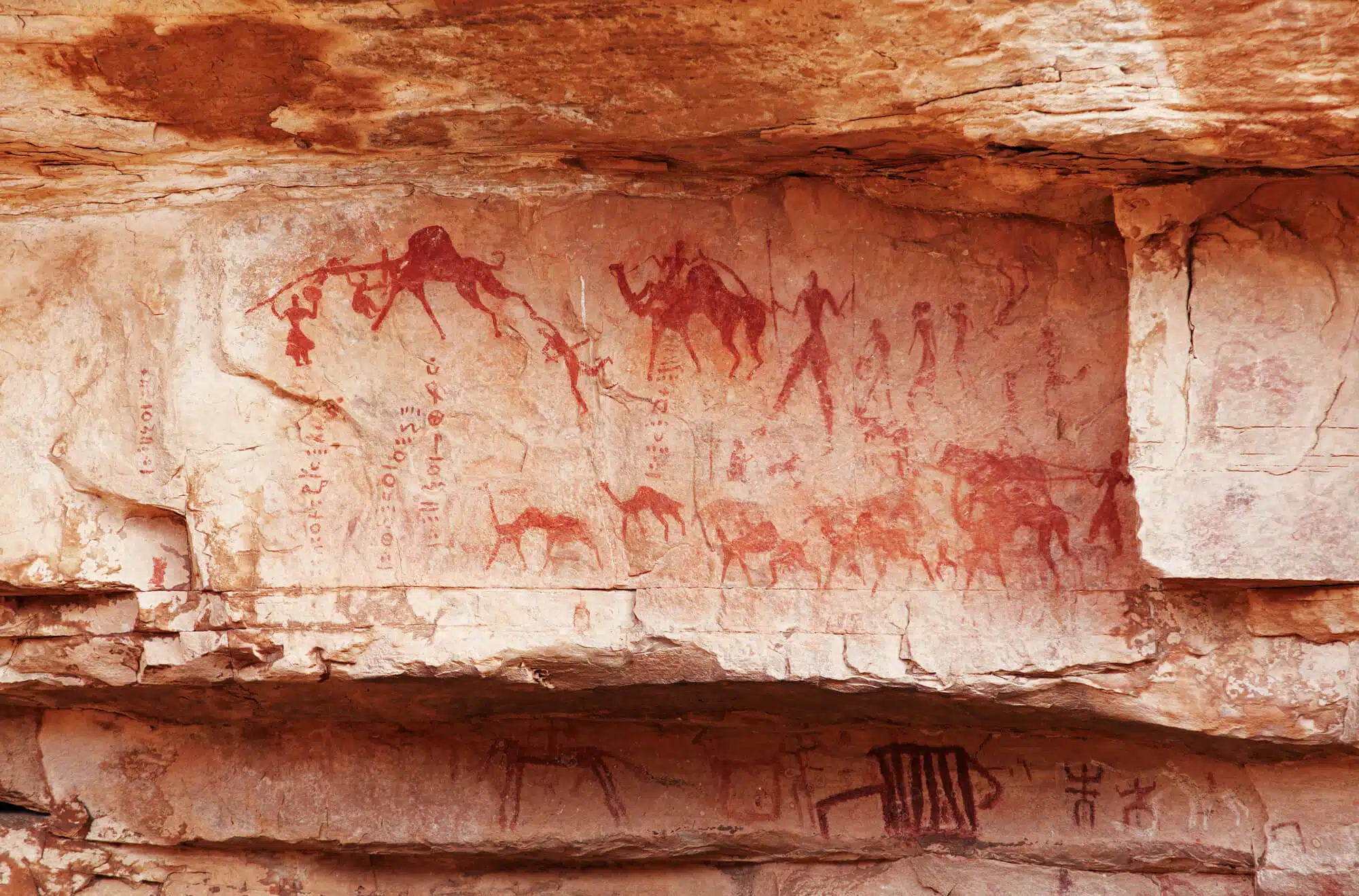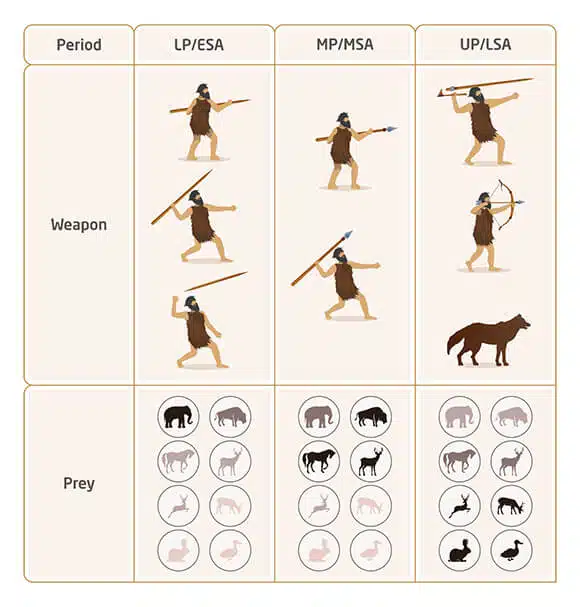
A new study of The Department of Archeology at Tel Aviv University States that the extinction of the large animals, on which the human diet was based, caused prehistoric man to also improve and perfect the hunting tools so that they were adapted to the hunting of smaller animals - starting from the early use of the stone tip mounted on the first wooden spear to the appearance of the later bow and arrow.
The research was conducted under the leadership of Dr. Miki Ben Dor and Prof. Ran Barkai from the Department of Archeology at Tel Aviv University. The study was published in the journal Quaternary. The researchers explain that one of the explanations in the professional literature is that the trend of change in hunting tools reflects an improvement in the cognitive abilities of ancient humans, but according to them, the process is the opposite, and the cognitive improvement resulted from the need to develop hunting skills that are suitable for hunting smaller and more agile animals.
Is there a connection between the appearance of the stone tips for spears and the decrease in the size of the hunted animals?
Dr. Ben Dor: "In ancient archaeological sites we find mainly animal bones and stone tools that were used for hunting and processing animals. The animal bones show the relative number of items identified from each species - what is the percentage of elephants, donkeys, etc. In this article we analyzed five test cases from South and East Africa, Spain and France, in the transition between the Lower and Middle Paleolithic period, about 300 thousand years ago, a period in which the Neanderthal man and Homo sapiens appeared. Our goal was to check whether there is a connection between the appearance of the stone points intended for mounting on spears and the decrease in the size of the hunted animals. Specifically, we examined the emergence of a technique for chipping stone called Lavois, which was used to prepare stone points for spears, and we found that indeed in all cases the two phenomena developed at the same time: the stone points prepared by the Lavois method appeared together with a relative decrease in the amount of large animal bones."
In an article from 2021, Prof. Barkai and Dr. Ben Dor offered a unifying explanation (theory), according to which a large number of central physiological and cultural adaptations that man underwent throughout the Stone Age were designed to preserve a sufficient energy return in view of the decrease in the size of the animals available for hunting. In a study they published last year, in collaboration with zoologists Jacob Dambitzer and Prof. Shai Meiri from Tel Aviv University, the researchers confirmed the extinction data of the large animals in the Levant during the transition from the Lower Paleolithic to the Middle Paleolithic about 300 years ago, and between the Middle and Upper Paleolithic about 40 years ago: at the beginning During the period, the dominant species in archaeological sites was an elephant weighing 12 tons - and at the end of the period it was a deer weighing 25 kilos. The data shows that the average weight of the animals hunted by humans a million years ago was 3 tons, compared to only 50 kilos about 20 thousand years ago, which means that there is a constant decrease in the size of the animals hunted on the timeline.
Dr. Ben Dor: "We know from studies conducted in contemporary hunter-gatherer societies that in order to hunt a large animal like an elephant, a wooden spear is sufficient. Because the hunters first limit the animal's movement - for example, they push it into swamps or dig a hole for it covered with branches. That's why the spear is also called a stabbing spear: the hunt sticks the spear and waits for the animal to bleed. On the other hand, it is very difficult to restrict the movement of a medium-sized animal such as a ram. Even if the hunter succeeds in hitting the animal with the wooden spear - the animal will run away. A spear hit with a stone tip guarantees a more significant wound, which will reduce the distance and speed of the escape - and increase the chance of locating the animals after they collapse."

Why have hunting tools changed over the years?
Man started making stone tools about 3 million years ago, and started hunting animals about 2 million years ago. Homo erectus, the ancestor of all later human types, initially used a wooden spear that was probably used for thrusting at short range. With the appearance of Homo sapiens and Neanderthal man, about 300 years ago, they began to put stone points on the wooden spears, in a relatively sophisticated technology called valua, which were probably used for both short-range thrusting and throwing. Then, about 50 years ago, Homo sapiens switched to regular use of more complex hunting tool systems such as bow and arrow and spears, the tips of which were produced with a different technology than the tips of the spears. At the end of the Upper Paleolithic period, about 25 years ago, new aids for hunting such as dogs, traps and fishing hooks appeared. Although researchers specializing in the study of hunting tools have long concluded that different tools were used to hunt different animals in different ways, no unifying explanation for the changes has ever been offered.
Prof. Barkai adds: "We are in a process that has lasted for ten years to find a unified explanation for central phenomena in the cultural and biological evolution of man. It all started at the Kesem Cave archaeological site, near today's Kesem Junction, when we suggested that elephants, which were a major component of the diet of humans who lived in the area we live in for a million years, disappeared as a result of overhunting and climate change. With their disappearance, humans had to adapt to obtaining the same amount of calories from a greater number of smaller animals. Following the research we conducted there, we realized that animals played a critical role in human development: at first they hunted the biggest, and after those disappeared they moved on to the next in line, until it no longer paid off energetically to hunt animals - and they began to domesticate them and the plants. This is how the agricultural revolution began."
The researchers from Tel Aviv University do not reject the accepted explanation, according to which the volua technique is a product of human cognitive development. The method differs from "regular" sharpening of a stone point in that first a block of quality stone is chipped, shaped and sculpted, and only at the end of the process is the point removed from it in one stroke. In other words, the mason has to visualize the final product of his work. According to Dr. Ben Dor and Prof. Barkai, this explanation is partial and does not point to an environmental factor for change, as is customary in evolutionary explanations.
"Here, for the first time, we offer an explanation for one of the fascinating questions in prehistoric archaeology: why do tools change?" says Prof. Barkai. "The accepted explanation is that the tools change due to an improvement in the mental capacity of humans, so they suddenly knew how to imagine a sophisticated process of chipping stones using the Lavoisier technique. But this is not a convincing explanation, because then one can ask why humans suddenly became smarter? What was the advantage of a large brain with a high energy cost? Why did the change in human cognitive abilities suddenly occur? We show that the material and biological changes are related to the animals they hunted. To hunt a small and elusive animal, humans had to be more focused, fast, sharp-eyed and cooperative. They had to develop tools that would allow them to hunt from a distance, and develop the ability to track animals. And finally, they had to carefully select the hunted animals according to the amount of fat found in them. Hunting a large number of agile deer has a higher energy cost than hunting a huge elephant, and this is the evolutionary pressure exerted on man to perfect himself and perfect his tools - so as not to harm the energetic return."
More of the topic in Hayadan:
- "I feel like I'm at the forefront of science that thousands of people are engaged in"
- Were other human species the first victims of the sixth mass extinction?
- The Aztecs - from the spear of the sun to broken spears
- The human brain grew following the extinction of large mammals and the transition to hunting small mammals
- Bounty hunting does not help prevent the extinction of lions
